What Is Sieve Analysis Test?
Important Point
Sieve analysis, often referred to as sieve analysis of aggregate, is an analytical technique used to determine the particle size distribution of granular material with macroscopic granular sizes.
This sieve analysis technique, crucial for both sieve analysis of coarse aggregate and sieve analysis of fine aggregate, involves the layering of sieves with different grades of sieve opening sizes.
This finest sized sieve lies on the bottom of the stack with every layered sieve stacked above in order of increasing sieve size.
When a granular material is added to this top and sifted, the particles of this material are separated in the final layer the particle couldn’t pass.
Commercial sieve analyzers weigh every individual sieve from the stack to determine the weight distribution of these particles. This base of this instrument is a shaker, which facilitates the filtering.
Sieve analysis is important for analyzing materials because particle size distribution may affect a wide range of properties, like the strength of concrete, the solubility of a mixture, surface area properties, and even their taste.
As per the below methods for Sieve Analysis Test.
1. Sive analysis test for Coarse aggregate
2. Sive analysis test for Fine aggregate
Also, read: What Is FSI | What Is FAR | What Is Premium FSI | FSI Full Form | FAR Full Form
Sive Analysis Test for Coarse Aggregate
Apparatus Sive Analysis Test for coarse aggregate sieve analysis:
- Dry Oven
- IS Sieves 40 mm, 20 mm sieve analysis, 16 mm, 12.5 mm, 10mm, and pan – specifically for sieve analysis of coarse aggregate 20mm.
- IS Sieves 20 mm, 16 mm,12.5 mm, 10 mm, 4.75 mm,2.36mm and pan – for Analysis of 10/12.5 metal.
- Weigh scale to the accuracy of 1gm
- Wire Brush
- Metal Trays etc.
Procedure for coarse aggregate test and Sive Analysis Test for Coarse Aggregate:
- A sample of aggregate shall be collected as given earlier.
- Sieves shall be cleaned and arranged in sequence in descending order. Pan shall at the lowermost end and Lid on top.
- Take around 5 kg of sample and dry it in an oven at a temp of 100-1100
- The dried sample shall be then weighed ( 5 kg preferably) and sieved successively on sieves starting with 40mm and then through 4.75mm (For 20 mm down an aggregate size ) and through 2.36 mm (For 12.5/10 mm down an aggregate size).
- Each sieve shall be shaken at least for two minutes on a clean tray until no more trace passes.
- The motion shall be varied like back and forth, left to right, circular clockwise and anti-clockwise and with frequent jarring.
- Material shall not be forced through the mesh. But for coarser than 20mm particles, placing is permitted (passing particles through sieve opening manually).
- Sieves shall be brushed from underneath of mesh and pass on to the next.
- On completion of sieving, material retained on each sieve is to weigh Separately.
- Check for permissible limits for passing.
Also, read: What Is Plaster | Plaster Ratio | History of Plastering | Requirements of Good Plaster
Reporting Sive Analysis Test for Coarse Aggregate:
- The cumulative % by weight of the total sample passing each sieve, to the nearest whole number.
Or
- The % by weight of the total sample passing one sieve and retained on the next Smaller sieve to the nearest 1 decimal.
- Check for permissible limits for passing.
Sive Analysis Test for Fine Aggregate
Apparatus Sive Analysis Test for Fine Aggregate:
- Drying Oven
- IS Sieves 10 mm, 4.75mm, 2.36 mm, 1.18 mm, 600 microns, 300 microns, 150 mm & Pan
- Weigh scale to the accuracy of 1gm
- Brush
- Metal Trays etc.
Also, read: Difference Between Carpet Area and Built-up Area
Procedure Sive Analysis Test for Fine Aggregate:
- A sample of sand shall be collected as given earlier.
- Sieves shall be cleaned and arranged in sequence in descending order. Pan shall at the lowermost end and Lid on top.
- Take around 1 kg of sample and dry it in an oven at a temp of 100-1100
- The dried sample shall be then weighed ( 1 kg preferably) and sieved successively on sieves starting with 10mm and then through 150 microns.
- Each sieve shall be shaken at least for two minutes on a clean tray until no more trace passes.
- The motion shall be varied like back and forth, left to right, circular clockwise and anti-clockwise and with frequent jarring.
- Material shall not be forced through the mesh. Lumps in fines shall be broken against the wall of a sieve.
- Sieves shall be brushed from underneath of mesh and pass on to the next.
- On completion of sieving, material retained on each sieve is to be weighed separately.
Also, read: Density of Cement Sand and Aggregate | Cement Density | Sand Density | Aggregate Density | list of Density
Calculations of Sive Analysis Test for Fine Aggregate:
- Fineness Modulus: Add values of Cumulative % Retained on each sieve and Divide by 100.
- Normally the accepted limit of FM is valued between 2.2 to 3.2.
- A higher value of FM indicates coarser sand, whereas lesser value indicates a finer one.
- Grading Zone of Fine Aggregate – Value is shown between I to IV.
- Where zone- I is associates with Coarser Fine aggregate, and Zone IV is Finer.
- Zones are decided from values of 600 microns passing % in sieve analysis. (Refer Table-4 of IS: 383)
- Zone –I – 15-34%, Zone-II – 35-59 %, Zone-III- 60-79%, Zone-IV- 80-100%
Reporting:
- The cumulative % by weight of the total sample passing each sieve, to the nearest whole number.
Or
- The % by weight of the total sample passing one sieve and retained on the next smaller sieve to the nearest 1 decimal. Calculate the F.M. of the material and decide to read the Zone of material.
Sieve Analysis Test
A sieve analysis or gradation test determines the distribution of aggregate particles by size within a given sample. This information can then be used to determine compliance with design and production requirements.
Particle Size Analysis by Sieving
In sieve analysis, the particle size distribution is defined using the mass or volume. Sieve analysis is laboratory test procedure in which particles will move vertically or horizontally through sieve mesh.
Particle Size Distribution Test
A Particle Size Distribution Analysis (PSD) determines and reports information about the size and range of particles representative of a given material. This analysis can be performed using a variety of techniques; the most suitable will be determined based on the sample properties and question at hand.
Soil Gradation Test
Soil gradation test is a practice or procedure used commonly used in civil engineering to assess the particle size distribution also called gradation of a granular material by allowing the material to pass through a series of sieves of progressively smaller mesh size and weighing the amount.
Why Gradation Test Is Done?
A sieve analysis or gradation test determines the distribution of aggregate particles by size within a given sample. This information can then be used to determine compliance with design and production requirements.
How Do You Do a Grain Size Analysis?
The test is conducted by placing a series of sieves with progressively smaller mesh sizes on top of each other and passing the soil sample through the stacked sieve “tower”. Therefore, the soil particles are distributed as they are retained by the different sieves.
Particle Size Distribution Test Procedure
Particle size distribution is determined by weighing the material retained on each of the sieves and dividing these weights by the total weight of the sample. A correction is made for the moisture content of the sample so that all calculations are based on dry weight.
Grain Size Analysis
Grain size analysis is a typical laboratory test conducted in the soil mechanics field. The purpose of the analysis is to derive the particle size distribution of soils. Sieve Grain Size Analysis is capable of determining the particles’ size ranging from 0.075 mm to 100 mm.
What Is the Purpose of Grain Size Analysis?
The grain size analysis is widely used in classification of soils. The data obtained from grain size distribution curves is used in the design of filters for earth dams and to determine suitability of soil for road construction, air field etc.
Particle Size Distribution Curve Sieve Analysis
The results of mechanical analysis (sieve and hydrometer analyses) are generally presented by semi-logarithmic plots known as particle-size distribution curves. The particle diameters are plotted in log scale, and the corresponding percent finer in arithmetic scale.
What Is Particle Size Distribution Curve?
Particle size distribution is the method of separation of any soil sample into different fractions based on their particles sizes. There is little possibility that a soil is composed of all the particles of just one size. In usual situations soil mass consists of particles of many different sizes.
Particle Size Distribution Sieve Analysis
Sieve analysis is a technique used to determine the particle size distribution of a powder. This method is performed by sifting a powder sample through a stack of wire mesh sieves, separating it into discrete size ranges. Vibration allows irregularly shaped particles to reorient as they fall through the sieves.
What Is a Soil Sieve Analysis?
Sieve analysis is a method that is used to determine the grain size distribution of soils that are greater than 0.075 mm in diameter. It is usually performed for sand and gravel but cannot be used as the sole method for determining the grain size distribution of finer soil.
Gradation Test of Soil
Soil gradation is a classification of a coarse-grained soil that ranks the soil based on the different particle sizes contained in the soil. Soil is graded as either well graded or poorly graded. Soil gradation is determined by analyzing the results of a sieve analysis or a hydrometer analysis.
What Are the Test of Grading of Soil?
A sieve analysis or gradation test is a practice or procedure used commonly used in civil engineering to assess the particle size distribution also called gradation of a granular material by allowing the material to pass through a series of sieves of progressively smaller mesh size and weighing the amount.
Sieve Analysis of Soil
Sieve analysis is a method that is used to determine the grain size distribution of soils that are greater than 0.075 mm in diameter. It is usually performed for sand and gravel but cannot be used as the sole method for determining the grain size distribution of finer soil.
Why We Do Sieve Analysis of Soil?
Sieve analysis determines the particle size distribution of a given soil sample and hence helps in easy identification of a soil’s mechanical properties. These mechanical properties determine whether a given soil can support the proposed engineering structure.
Grain Size Distribution Test
This test is performed to determine the percentage of different grain sizes contained within a soil. The hydrometer method is used to determine the distribution of the finer particles.
Particle Size Distribution Test Method
A Particle Size Distribution Analysis (PSD) determines and reports information about the size and range of particles representative of a given material. This analysis can be performed using a variety of techniques; the most suitable will be determined based on the sample properties and question at hand.
How Do You Calculate Particle Size Distribution?
Particle size distribution is determined by weighing the material retained on each of the sieves and dividing these weights by the total weight of the sample. A correction is made for the moisture content of the sample so that all calculations are based on dry weight.
What Is a Sieve Used for in Soil?
Sieve analysis is a method that is used to determine the grain size distribution of soils that are greater than 0.075 mm in diameter. It is usually performed for sand and gravel but cannot be used as the sole method for determining the grain size distribution of finer soil.
Sieve Set for Soil Analysis
Sieve analysis is a method that is used to determine the grain size distribution of soils that are greater than 0.075 mm in diameter. It is usually performed for sand and gravel but cannot be used as the sole method for determining the grain size distribution of finer soil.
Sieve Analysis of Sand
Sieve Analysis Test of Sand is done to check the gradation of sand particles. Sand particle distribution in sand volume is important for good quality concrete and mortar. In this test, the sand sample is passed through a series of IS sieve sizes ordered from bigger to smaller sizes at the bottom.
Sieve Test Procedure
Sieve analysis is a technique used to determine the particle size distribution of a powder. This method is performed by sifting a powder sample through a stack of wire mesh sieves, separating it into discrete size ranges. A sieve shaker is used to vibrate the sieve stack for a specific period of time.
What Is the Sieve Size for Grain Size Analysis?
The analysis is conducted via two techniques. Sieve Grain Size Analysis is capable of determining the particles’ size ranging from 0.075 mm to 100 mm. Any categorization of grains larger than 100mm will be conducted visually whereas particles smaller than 0.075 mm can be distributed using the Hydrometer Method.
What Is Grain Size Distribution Curve?
This curve is obtained from the result of sieve size analysis and it is plotted for grain or particle size versus percentage finer. This curve is otherwise called gradation curve. It is used to know about the gravel and sand and whether it if poorly graded or well graded.
Sieve Analysis Sizes
Sieve analysis helps to determine the particle size distribution of the coarse and fine aggregates. A set of IS Sieves of sizes – 80mm, 63mm, 50mm, 40mm,31.5mm, 25mm, 20mm, 16mm, 12.5mm, 10mm, 6.3mm,4.75mm, 3.35mm, 2.36mm, 1.18mm, 600µm, 300µm, 150µm and 75µm.
What Is Sieve Analysis Test?
A sieve analysis or gradation test determines the distribution of aggregate particles by size within a given sample. This information can then be used to determine compliance with design and production requirements.
Like this post? Share it with your friends!
Suggested Read –
- Earth Dam
- Fine or Coarse
- Coarse Grained Soils
- Testing for Silt Content in Sand
- Difference Between 33, 43 and 53 Grade Cement
- What Is a Field Dry Density Test | Different Type of Field Density Tests
- What Is Slump Cone Test | Principle of Slump Test | Types of Concrete Slump
- Dog-Legged Staircase | What Is Staircase | Advantages & Disadvantage of Dog-Legged Staircase

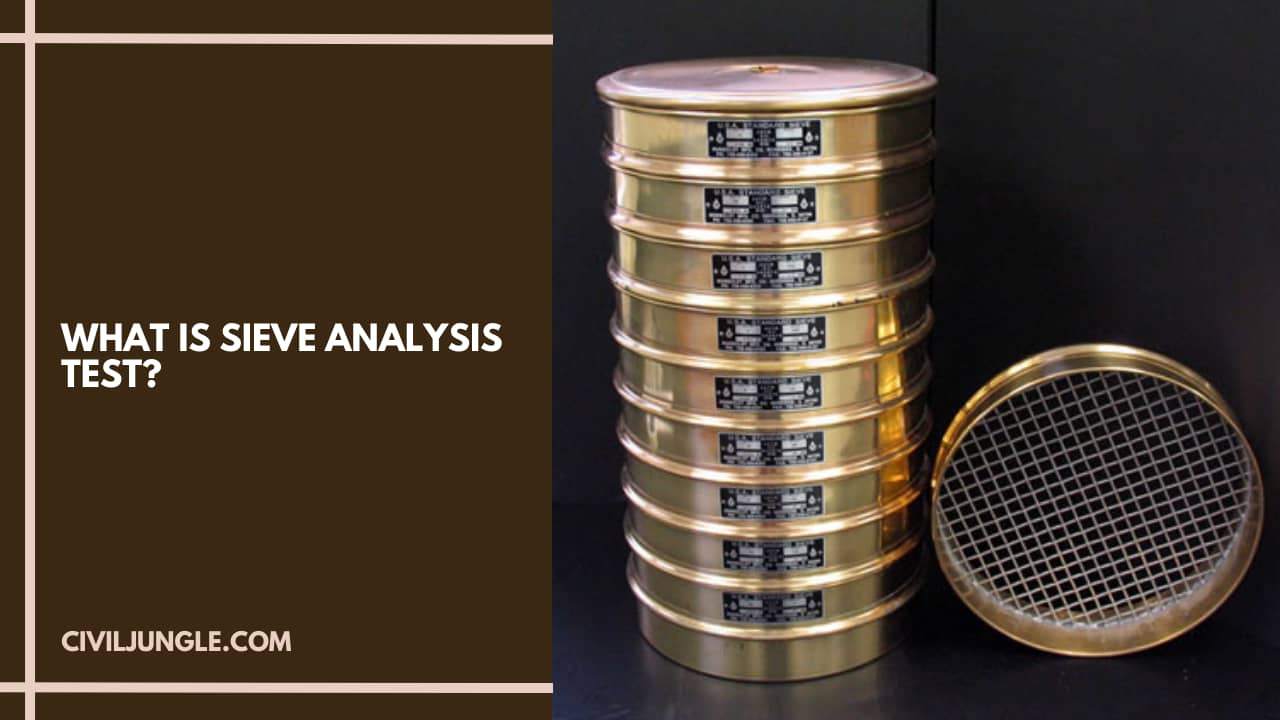
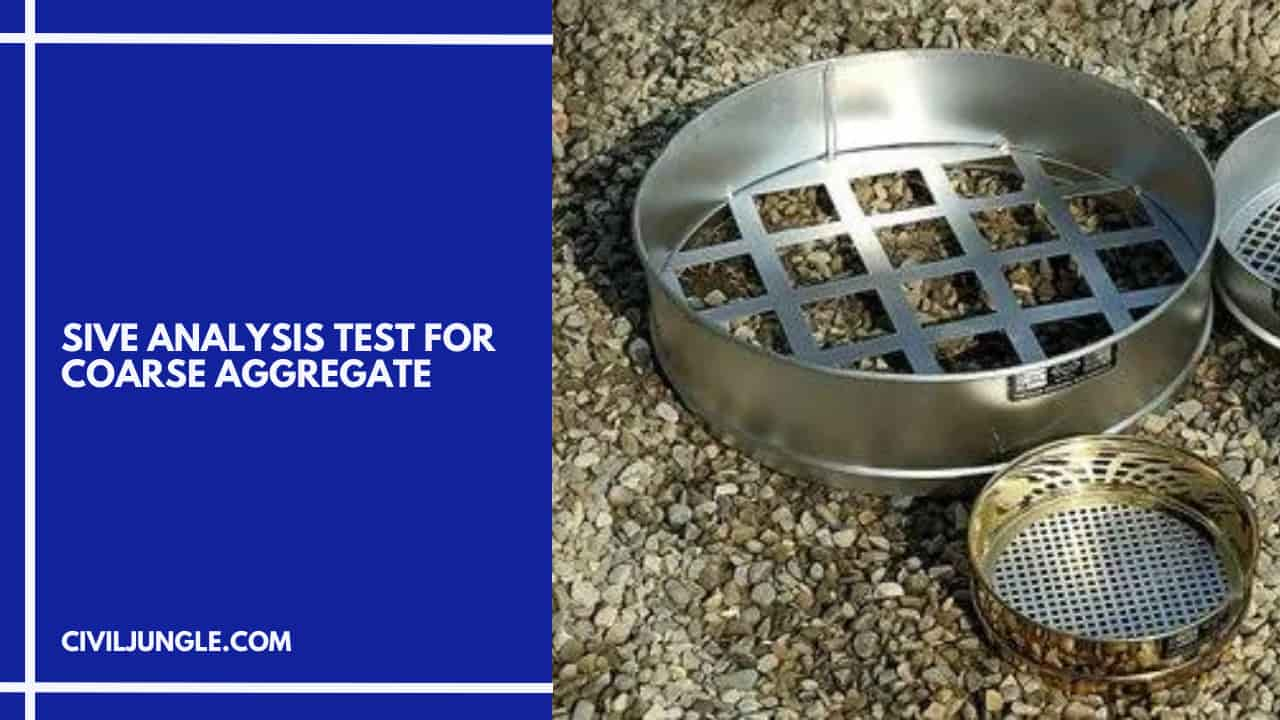

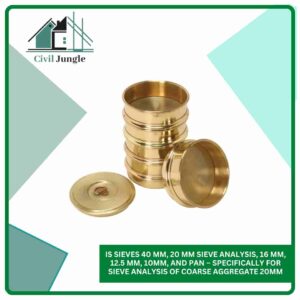
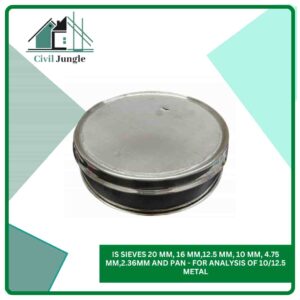
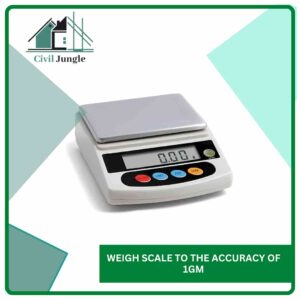


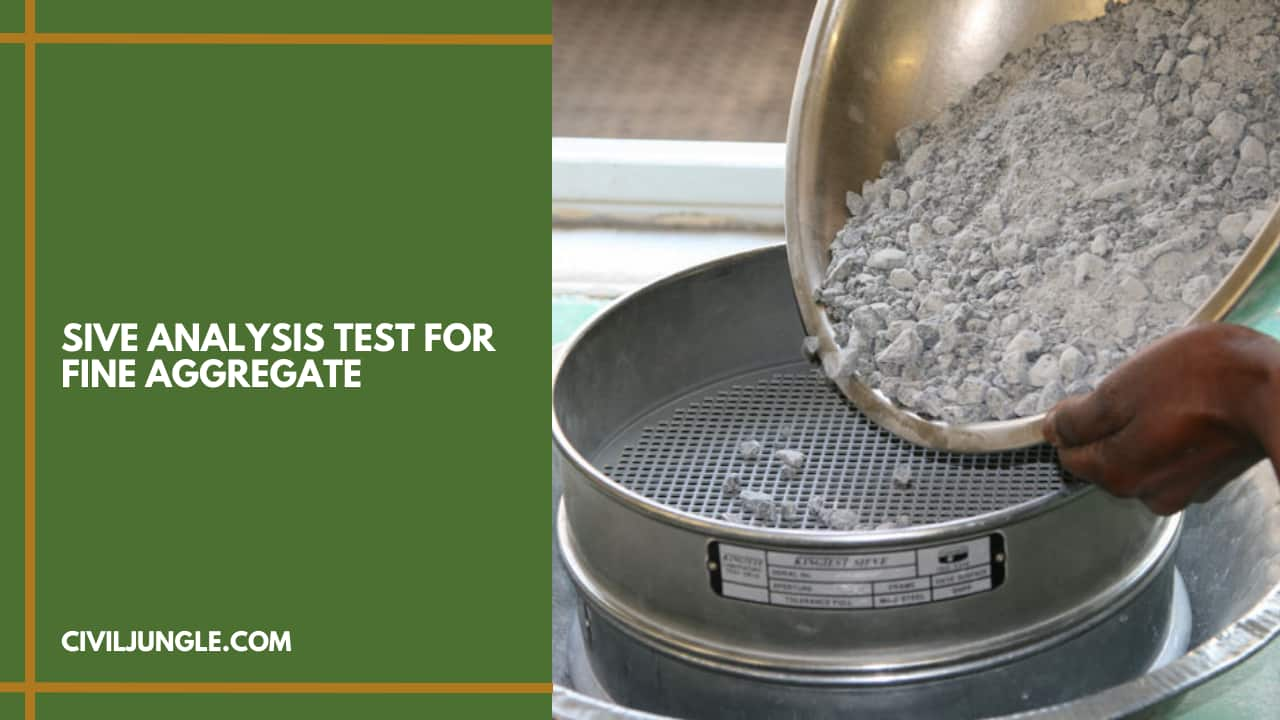


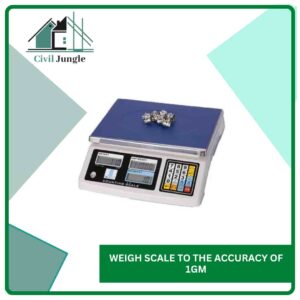


Leave a Reply